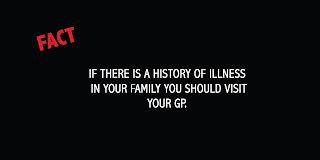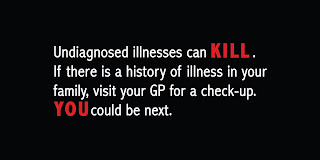Tuesday 15 December 2009
Collection 100... Research Proposal
Monday 14 December 2009
What If...
One story that caught my attention was about a gang operating in the city centre who snatch purses in supermarkets, relating back to the brief this would be an appropriate topic, it is a problem that will affect the public, the fact that the story is in the paper shows it is a genuine problem.
Another story that caught my attention was a drugs raid on a night club in the city centre, this would not affect as many people as the previous issue would, but it would still affect some sector of the general public.
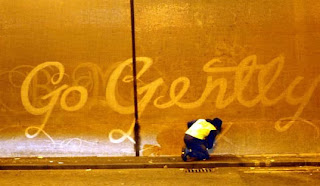
After we shared all our research the subject homelessness was brought up, it wasn’t an idea that fell into place straight away as I think we as a group had our hearts set on the graffiti idea, however, a few more ideas were put forward on the subject of homelessness and as we as a group lacked knowledge on homelessness in Leeds, maybe the public lacked knowledge.
Meryem joined our group today as she had been away, so I gave her a brief overview of what the group had come up with, so she was as up to date as we were, instead of catching up and missing out on voicing her opinion.

When speaking to my Mum, she said some of the ‘clients’ are homeless because they are funding for their habit, so cannot afford rent etc. and some are homeless for whatever reason and end up on drugs. She also said that some are not technically classed as homeless as they ‘sofa-surf’ on friend’s sofas, so while they have no fixed address, they aren’t sleeping rough. This touched upon an issue we already faced, what exactly is homelessness, as there are different types, and the definition varies form country to country. For example the types of homelessness we have here are:
(taken from the Crisis website)
- Legally homeless: A household is legally homeless if either there is no accommodation that they are entitled to occupy or they have accommodation but it is not reasonable for them to continue to occupy this accommodation.
- Officially recognised as homeless: Those who are both legally homeless and have successfully applied to their local authority to be classified as such in the current year. A household can be legally homeless but not recognised by the state as being homeless because they have not applied to be classified as such.
- Statutory homeless: Households that have been found to be eligible for assistance, unintentionally homeless and falling within a priority need group and thus owed a main homelessness duty by a local housing authority.. In 2006-07, 73,360 households were accepted as statutory homeless in England. Local Authorities made 159,330 decisions on homelessness applications.
- Hidden homeless: This refers to homeless households, which may or may not have applied to local authorities for homeless status, but are not entitled to any accommodation. Crisis estimates that there are around 400,000 such 'hidden homeless' adults at any point in time.
We regrouped the following day to see what each other had found out, what was particularly interesting was the responses to the survey that was submitted on http://www.surveymonkey.com/, some of the questions were not worded correctly which lead to confusion, which meant the validity of the answers were not acceptable, and therefore I chose to ignore those answers. Sai and Nick analysed the answers in an attempt to formulate some statistics as part as our evidence.
71.4% of the respondents were 16-25, however some were in the 26-35, 36-45 and 56-65 category. The quantitative answers were much easier to analyse, and from this, the statistics could be generated, however, the qualitative answers were much more complex. A total of 28 participated, the majority being from Leeds, however there were responses from Scunthorpe, Nottingham, Birmingham, Manchester, Lincoln and Wisconsin, USA.
60.7% of the respondents felt that homelessness is an issue in their city of residence. Another question that was asked is, ‘How do you feel when you see a homeless person?’ I personally did not expect the answers that were given, the majority of people, did seem to have a lot of sympathy towards homeless people. 80.8% said that when they saw a homeless person they just walked on past them, and 11.5% said they would give them money. There was an opportunity on this question to give a qualitative answer, where someone even commented that they had housed a homeless person before.
Another interesting question was ‘Why do you think people are homeless?’ the vast majority assumed that the main cause was substance misuse and family/relationship breakdowns. Other answers included financial difficulties, a fairly obvious cause, mental health issues, disability, and job loss. After research on the Leeds City Council website, one of the most common causes of homelessness is parental eviction and domestic violence.
When asked, ‘Do you think there is enough help for the homeless in your city of residence?’, 69.6% thought no, there was not enough help. Again, there was an opportunity to make a comment on this, 10 people made a comment, around half of which were unsure of what help is actually available, one comment made was ‘…there needs to be initiatives to stop people becoming homeless, rather than to help them when they are.’ I think this comment is correct, but there still needs to be a lot of help for those who are homeless, as it is not something that can be easily prevented sometimes.
Nick had taken out a book from the library about the St. George’s Crypt, which is a charity that cares for homeless people in Leeds, and has done so for around 80 years. I went on to the website to find out more information and read an interview with a homeless man called Dougie, who has now passed away, he went to university and after finishing travelled the world, got married and had children, but sadly his wife was diagnosed with breast cancer, and that is where Dougie’s downward spiral started, as when his wife died he began drinking more and more, which resulted in losing his house, children and job. It wasn’t until he ended up in hospital in a coma that he realised he needed to stop drinking.
As a further point of research, I then decided it may be appropriate to contact St. George’s Crypt to ask a few questions as this may help us to identify a more specific issue. I rang the crypt up and spoke to a gentleman named Martin, (who I believe is in charge of fund raising) after introducing myself and explaining a little about the brief, I asked ‘How many people of no fixed residence use the facilities?’ To this Martin replied, that on average about 60 a day come along to the crypt, and roughly 15 turn up at night. This made me wonder where the rest of them stayed for the night. Another question I asked was, ‘Without the public donating money or volunteering, in what ways could they help out’, the reason behind this question was, not everyone has the time or money to help, so it might be good to raise public awareness of how they can help out. The reply to this was that people could donate old clothes and blankets etc. which is partially the response I expected; however I was not expecting the next part of the answer, in which Martin said, that they would welcome people with skills such as teachers who could help out.
Due to the first part of the brief being about photography, we felt that photography may be an interesting point to research, 2 of my Black and White film photographs were of a gutter with rubbish and leaves which was quite an interesting image, and we felt that this may be a suitable type of image to use. I thought that may be some photographers that have taken photos of homeless people; I found one book in the library but this was from less economically developed countries, so it wouldn’t have been appropriate. I think there was an absence of photos as some sites claimed that photographing homeless people was actually illegal, however some claimed it wasn’t. It was then that Hazel came up with an idea that maybe photographing someone acting as a homeless person may be unnecessary, and I guess it is also a little inappropriate, but then she suggested that we could use an image of where a homeless person may have sat. Looking back now I realise, this was a waste of time making these decisions as we had not yet identified a problem.
For the presentation on Friday, we had 3 A3 boards to create, Will and Meryem were in charge of our first board; the problem. Nick and Sai were focussing on condensing the group’s research to ensure only relevant research was featured on the board. Hazel and I worked on the intentions board. The boards needed to be created, and from mine and Hazel’s past experience of working in a group we decided that to create the boards, one person should sit at the computer, Hazel, and the others would sit around and we would all have an equal say. This is better than the entire group going away and all creating something completely different which would then need to be negotiated. Everyone had a say on all the boards, but there were 2 main people assigned to each board, who would talk about that particular board in the presentation.
Our intentions were to have the general public as the target audience, particularly older people who may have more time, and our objective was to inform and educate them as to how they can effectively help the homeless without donating, this would be done in the form of a campaign. The boards were finished in good time, which gave us time to have two rehearsals in the tutorial room and have some lunch. We were very confident and felt positive about our presentation, this was reflected in the feedback we got from our tutor, Amber and a few peers who thought we had presented a strong presentation and had carried out lots of research. Our tutor gave us a lot of positive feedback and this boosted the positive vibe of the group even more.
Before we had chance to start the presentation one of the tutors, Fred had left the group. Because of this, we decided to get his feedback on our ideas, afterall, the more feedback we have the better. There were a few comments made from other peers about our ideas after the presentation commenting on the design of our boards, this is something we took quite seriously, and tried to aim for a professional look.
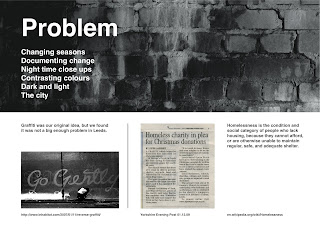


Fred had pointed out that the issue we were dealing with was too big for such a small time-scale brief, and basically told us to go away and find more problems that stem from homelessness. The group had a small chat before we went home for the weekend, and we all tried to look into issues within homelessness, that we could use as a problem. Amber was really pleased with the amount of research we had carried out, and thought the presentation was a positive reflection of the group's work.
Sunday 6 December 2009
Collection 100... Photography
A list of photographers was provided to help with research such as; Martin Parr, John Rankin, David Bailey and more.
The mandatory requirements for this was to have 100 (7.5cmx6cm) hard copies of photos with no white borders, but all cut to size. Within the photographs needed to be evidence of experimentation with composition and the interpretation of the images.
I also used a few photos from my holiday in July 2009 to Tenerife, of the rocky landscape, one photograph features part of Mount Teide, a volcano. I chose to use these images as the colours are warm and which makes a contrast with the photos taken for the project.
These photos featured mainly objects, people and words, and were also mainly in colour, as these were in colour I have tried to make the photographs colourful to contrast with the schemes used in the other photographs, for example, a sunset, a purple scarf, a lava lamp etc.
Here are a selection of my photos:
Looking at the photographs I had to pick a theme that linked them altogether, this proved to be quite tricky as some of my images were a little random, I then decided that changing seasons may be an appropriate topic.
Once the photos were collated, the next part of the brief was given out, titled ‘What If’ and the class was divided into groups. In my group, there was Hazel, Will, Sai and Nick, and their themes were:
- Documenting changes – differences and similarities
- Contrasting colours
- Dark and light and things that shine in the night
- Night time close-ups.
With the themes the others had, I felt like my subject fitted in quite well, as with seasons changing there are contrasts in colours, differences and similarities across the seasons, the difference in dark and light is also affected by this.
Tuesday 1 December 2009
Visual Language... Photography
Here is a sample of what we found:
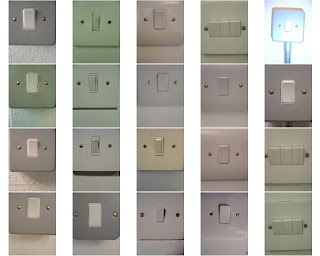
Thursday 19 November 2009
No News Is Good News- Message and Interpretation
At first I was going to use the exercise from before to help me with the posters, but decided if I was going to create a piece that is hard impact, I need to think of something that will have a major impact because not everyone would be affected by Stephen Gately's death, but everyone could be affected by an undiagnosed heart condition.
From here I set my own brief:
Brief- to produce 3 posters in different styles that communicate the importance of checking for undiagnosed conditions when illness runs in the family.
Target Audience- families with a history of illness.
Tone- concise, immediate impact, hard-hitting.
Format- portrait/landscape- I will investigate both.
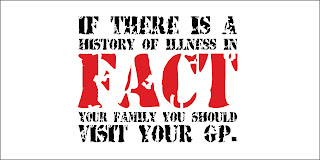 This idea looks at using all of the text in the stamp style font, 4YeoStamp, I am not sure this communicated the right kind of message, however I was intrigued as to how the idea would look on a diagonal, as if it had been stamped, as stamps aren't always that precise.
This idea looks at using all of the text in the stamp style font, 4YeoStamp, I am not sure this communicated the right kind of message, however I was intrigued as to how the idea would look on a diagonal, as if it had been stamped, as stamps aren't always that precise.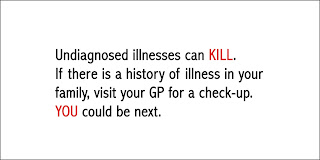 I feel quite strongly about this piece, and think it could be a potential final resolution to my text only poster. It is clear concise, and I think the colours work well. The words kill and you are red to make them stand out from the rest, to make the audience read the full information so they are aware what might effect them.
I feel quite strongly about this piece, and think it could be a potential final resolution to my text only poster. It is clear concise, and I think the colours work well. The words kill and you are red to make them stand out from the rest, to make the audience read the full information so they are aware what might effect them.Friday 30 October 2009
No News Is Good News
I chose the headline 'Nothing will ever be the same without our dearest friend Stephen...rest in peace, brother', from The Sun, mainly because of the amount of media coverage the story has had, and some of the mystery surrounding it, which may come across as morbid, but at the time of print, the public were unaware what had killed Gately.
There were a number of ideas within this concept that would be research points:
- The tattoos (that Boyzone have got as a memorial to Stephen).
- Stephen’s husband – Andrew Cowles.
- The remaining band members.
- Funeral.
- The statement read out by Ronan Keating.
- Family and other mourners.
- Stephen’s life.
- The actual cause of death.
- The night of the death.
- Fans’ tributes.
Three ideas that I will take forward and investigate are:
- The remaining band members, especially Ronan Keating’s speech at Palma Airport.
- The funeral, the service in Majorca at a chapel, and a memorial service in London.
- The death and the events leading up to it- what really happened?
To do this the only research methods to get this key information is from the newspapers and internet sites, I did this with an open mind so I wouldn't believe the first story I read. I collected research from a number of sources, The Guardian, The Independent, The Daily Telegraph and The Daily Mail, I simply selected these because they are known for there straight to the point, no nonsense views, unlike The Sun, my original choice of paper, which does and is known for embellishing. I also took information from Wikipedia on the view of Gately's death, again with an even more open mind, as Wikipedia is editable by the public and may hold biased views.
I highlighted key points throughout the documents, and from here I narrowed down the key points even more and put them on to a mind map so cross examination could be done, as some papers shared similar views, while others contrasted completely.
Ready for the next session, we had to note down a statement of fact and a statement of opinion from the research, backed up by supporting evidence;
STATEMENT OF FACT:
Stephen Gately died from a genetic, undiagnosed disease known as pulmonary oedema.
EVIDENCE:
The post mortem results showed that the cause of death was natural (pulmonary oedema), which was paternally inherited.
STATEMENT OF OPINION:
'...our world changed forever when we lost our friend.'
EVIDENCE:
This is from a statement read out by Ronan Keating on behalf of the remaining members of Boyzone, read out atPalma Airport in Majorca.
We were then given the task of picking out 10 adjectives, 10 verbs, 10 objects (hand drawn) and 10 symbols (also hand drawn) which related to our research:
Adjectives: cold, numb, white, happy, sad, beautiful, bubbly, solemn, natural, brightest, heavy.
Verbs: speak, die, cry, carry, promise, pray, smoke, drink, made, change.
Objects (drawn): coffin, church, plane, flowers, star, gravestone, joint
Symbols (drawn): skull and cross bones, gay pride flag...
This exercise helped to kick start the visual thinking process ready to be given the next part of the brief...
Wednesday 28 October 2009
Alphabet Soup...Typeface
This is what I found out:
SIBLINGS: Younger brother.
BIRTHDAY: July 23rd (Cancer/Leo)
EARLIEST MEMORY: On holiday in France running along, she fell over and cut her leg and went running back to show her Mum.
PERSON YOU ADMIRE: Her Mum- because she manages to do so much.
MOST TREASURED POSSESSION: Mac.
FILM: Anchorman, or comedies and chick flicks.
DESIRED SUPER POWER: Teleportation- to visit friends, family and dog in India and Dubai.
EXTINCT ANIMAL TO BRING BACK: Diplodocus.
MUSIC: Lots, not heavy.
HOBBIES: Golf (joint family activity) and Horse Riding.
FAVOURITE ANIMAL: Dog.
FAVOURITE SHOP: Forever 21.
ACTOR TO STAR IN FILM OF LIFE: Jessica Alba.
DINNER PARTY GUESTS: Russell Peters (comedian).
WHAT MAKES HER UNHAPPY: Bad weather, being cold, being away from family and friends.
FANCY DRESS: Cowgirl.
PHRASE: Go for it!
OTHER INFORMATION: Good cook, Quiet-ish, Half Indian/Half English, Lived in Middle East until last year.
From all this information, I created a mood board to give me a bit of a visual kick start as I was beginning to struggle on what to do. After much pondering I came up with four words to help me down the right path; fun, quiet, girlie, travel.
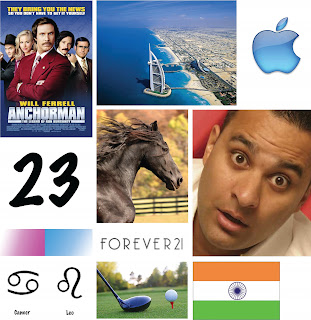
I thought of manipulating an existing font so that all the bowls were Apple logos, but then I realised it doesn't really say much about Maya. After experimentations with a range of fonts, that were mostly focussing on the word, girlie, I found a font called Afarat IBN Blady, which is an arabic style font. I thought this would be appropriate as using a font like this would be communicating Maya's background, as her home is in Dubai where they speak Arabic.
Maya's name in the font...

At a group crit, I listened to others ideas, and gave input and suggestions on people's work, when I presented my idea the group as a whole felt the letterforms as they are originally, are a bit harsh so I needed to soften them to make it more appropriate to Maya, also they commented on the fact that the letters were a solid black which made them quite bold, something else that wasn't quite apt. However, they did like how I had gone for something completely different, which was comforting as this was out of my comfort zone, and I didn't feel all that confident about my idea.
To manipulate the letterforms were tricky, and I felt like I had gone for something quite challenging so it was fun, but I didn't want to alter the letters too much and lose the whole Arabic feel, so I softened the edges around the letters and adjusted some of the heights. It was at this point that I was beginning to worry about putting logic to the font, as the letters varied in size, height and width so to try and adjust them to a standard height and width would be a) quite traumatising! and b) visually, it would not work. There were a few elements that were the same throughout however.
On the right is the original letter E, and on the left shows the manipulated version...
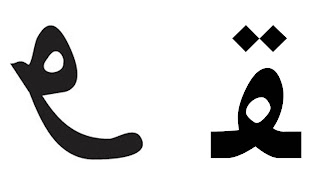
I chose to do a black outline of each letter so it would really emphasise the feminine shapes, i trialled outlines with other colours but the black appeared to work better. After three attempts at tracing the letters onto A1 I finally had a final piece, now I had to make the name badge. For this I just used Maya's first name, and the letters had no fill with a pink and blue stroke, the reason to pick these two as a colour choice are simply that these are Maya's favourite colours. It was quite tricky getting the letterforms to work altogether, because they work much better as individual letters rather than joined. I wanted to join each letter up so it still looked like Arabic script but the text wasn't very legible especially as the 'Y' is a strange letter anyway. In the end I did much prefer the badge, it was lighter and certainly brighter and I felt it communicated Maya (below).
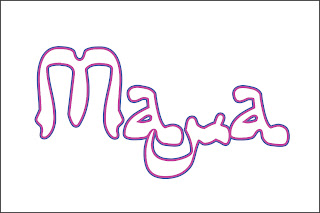 To me, the first 'A' and the 'Y' vaguely represent a smiley face, the bowl of the 'A' could be an eye, and the descender of the'Y' could be a smile. This isn't that noticeable but is still representative of Maya.
To me, the first 'A' and the 'Y' vaguely represent a smiley face, the bowl of the 'A' could be an eye, and the descender of the'Y' could be a smile. This isn't that noticeable but is still representative of Maya.
When it came to presenting my work, I did struggle due to a persistent, annoying tickly cough which made it hard to talk, but I think people knew roughly what I was trying to get at. Other than that, I think I did okay.
Sunday 25 October 2009
Visual Language... Ident
We chose the letter F as it is quite a simple letter with no diagonals or rounded sections, but we would add serifs on for added effect. Black card would be attached to the boxes, and the black card is what would make the shape of the letter. Where edges of the boxes met, some of the black card had to be cut in half, this is strange to describe in words, but makes sense once seen. We had a wide selection of boxes to work with from cigarette packets to cereal boxes.
The group worked well together, Ellis and Charlotte were at the view point instructing where to put the card, while Polly, Robyn and I were cutting up and placing the card on to the boxes.
These are a selection of photos taken by Ellis/Charlotte throughout:
Wednesday 14 October 2009
Visual Language Exercise Continued
Some of the words we were given were taken from the Alphabet Soup brief of when an alphabet had to be created to represent, duplicate, compress, dissect, hybrid and edit. We were then asked to create single squares to represent the word, which is what we did last week.
Duplicate: For the first square, there was one A, then the next square there were 2, for the third there was 4 and for the last square there was 8, so as a sequence I think they communicated the idea of duplication.

For the individual representation I combined all 4 squares into one, with an extra line at the bottom.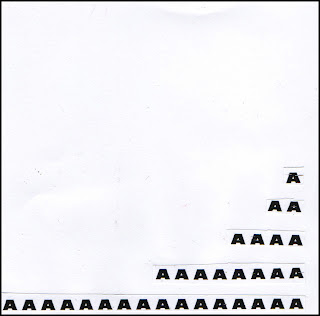
Compress: I found this quite tricky at first but decided to use2 lines of 4 bold A’s for the starting square, in the next square, the top line was still the same but the bottom line wasn’t bold, for the third one the bottom line of A’s were in a smaller font, and finally, the bottom line was smaller still. I think this showed the idea of the heavy, bold A’s compressing the other A’s so they progressively became smaller and smaller in size.
For the single square example I had 3 rows of 2 Bold A’s with some smaller Bold A’s underneath in 3 rows of 3 which slightly overlap to show the idea of compression and being squashed.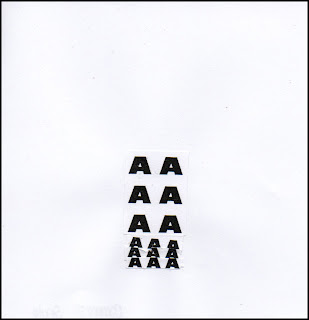
Dissect: This was another tricky one, as one of the rules set was that the letters could not be cut into, which would be ideal for this word. Instead, I cut out 4 rows of 4 A’s and stuck them down for the first square, for the next one, it was the same arrangement but the letters had been cut into individual columns. For the third example the 4x4 arrangement was the same but the letters have been cut even further into blocks of 2, and finally for the last square all of the A’s had been cut into individual letters.
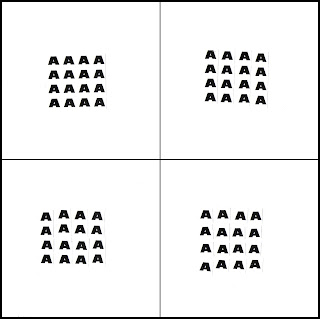
In the single example I had two rows of 4 A’s that have been placed at a 45 degree to each other, to show how they have been cut up.
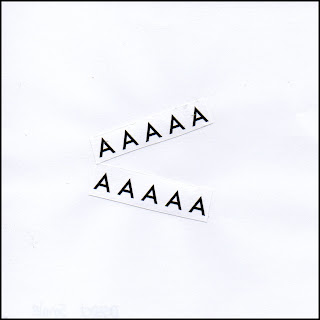
Hybrid: In the next series, I added a new font in each square, so for the first one, there was only one font, in the second there were two, in the third there were three and in the last sample, 4. This was to show how a hybrid is made up of different things. The way in which the letters were arranged were the same on each but bundled together at different angles, to show how the different fonts are part of one unit.
For the singular version, I feel this was probably my weakest representation, as it was the same four fonts used in the series, with one letter from each stuck in a line, again to show that the letters are part of one unit.
Edit: Some people found this quite tricky, however I found it was quite straight forward, as to edit something generally is to change or amend. So I started off with a letter A in the bottom left corner and then in the second example, the A was smaller in size and had been rotated 90 degrees clockwise and placed in the bottom right hand corner, for the third square the A is bold and standing upright in the top right corner. In the final square, the A is in the top left corner and has been rotated 180 degrees and is smaller than the previous one.
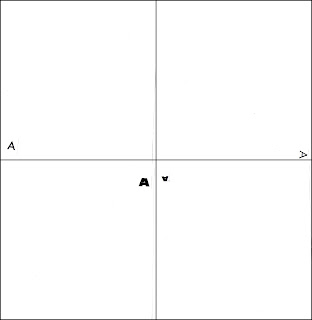
In the last single example, I have used 4 A’s, the first one is stood upright, the second is smaller and has been rotated 90 degrees clockwise, the third letter had been rotated a further 90 degrees and is bigger in size. The final letter has been rotated another 90 degrees and smaller.
Again, I found the exercise quite interesting as it really gets you to 'think outside the box'. I did find it challenging but that made it all the more intriguing, and again, it is great to see how the same information is interpretted differently by other people.
Sunday 11 October 2009
Visual Language Exercise
Closed: For this word, I cut out 4 strips of 3 A’s and formed a square in the centre of the page with the strips overlapping; this is to give the feeling of something being closed in.
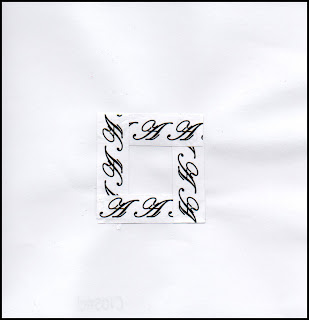
Difference: In this example, I decided the most obvious way to represent this was to have 2 A’s that were different in size, e.g. large and small and different in style, e.g. script and sans serif.
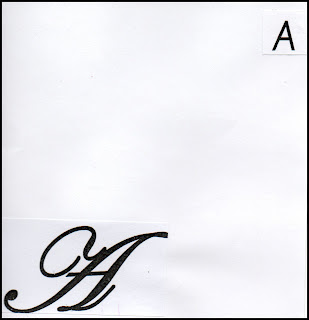
Link: To create the idea of links, I decided to overlap the A’s to show how they cross over to form individual links.
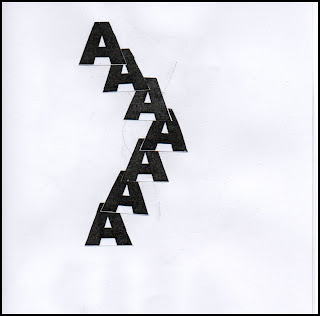
Loop: Here, I created a loop out of the A’s, with a slight overlap at the loop to show it did cross over.

Space: My representation for space, is very obvious, a small A in the corner of the page.
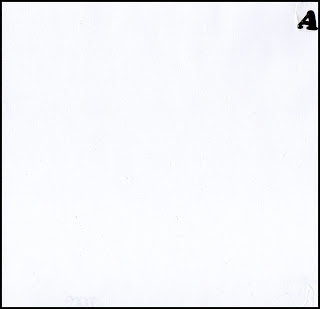
Horizontal: This is probably the most obvious out of the series, it was simply four A’s laid horizontally across the page.
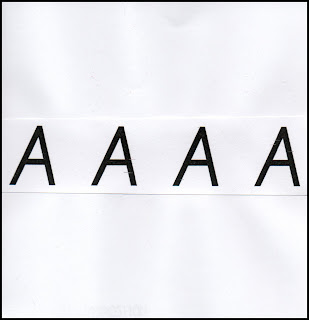
Above: This was quite simply a small A at the bottom middle of the page, with four bolder A’s directly above it, the reason for the difference in size was to show the A at the bottom was a long way below the A.
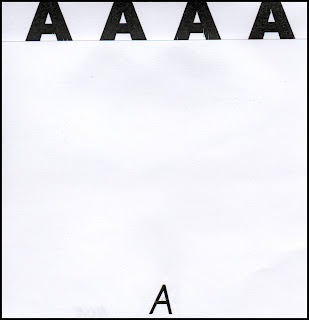
Form: For this one I decided to do the shape of an A, which I felt would be the most appropriate, although I was unsure if I was communicating the right idea.

Positive: I first thought of a graph and positive correlation, totally forgetting of the symbol for positive, a plus sign, which is what I ended up doing for this one.

Finish: I wasn’t sure what to do for this one initially, the first image that came into my head was a black and white chequered flag, but as the type was black and background was white, I thought this may be tricky to do, so I thought of an actual finish line.
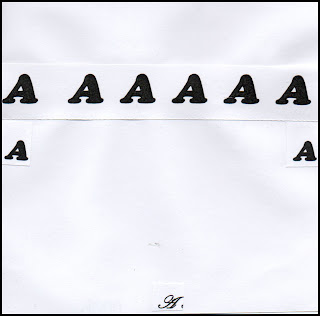
After we had created these representations, we sat in front of other people’s examples to see if we could guess the word that was being presented, for the person’s I looked at, I got 6 out of 10, but the person that sat in front of mine got 10 out of 10, so I think that shows that I successfully represented each of the words. Although, for me personally, I think a few of my examples were a bit weak, although I maybe could have achieved 10 out of 10 through process of elimination.
Friday 2 October 2009
Alphabet Soup
I sketched different ways in which I could exaggerate, for example, I could exaggerate the lines used to create the letterform, or exaggerate a specific part of the letter, such as the bowl or stem, I also thought about pixelating the letterforms which would be anohter method of exaggeration. Another sketch I did was a letter E drawn in one point perspective with a vanishing point. I did quite like this but I decided to really show exaggeration, I needed to work in 3D.
I then had to choose a font which at first was going to be something plain and sans serif and easily manipulated like Helvetica, however I found a font called "Exaggerate" and the letters look like they are facing sideways, which I found appropriate.
Now I had found my font I originally settled with exaggerating the depth of each letter, I wanted to achieve this through decoupage, however once I had presented this idea in a group crit, a few members of the group thought that my idea didn't communicate this and it looked like I was trying to communicate 'Layers', one of the other words. I completely agreed with this and decided to do something similar but instead of having 4 or 5 letters stacked on top of each other separated with foam squares, I would have a piece of black card, with a letter stuck on with 2 foam squares to raise it up, another letter stuck on top of that with the same amount of foam sqaures with one section of the letter more raised than the other.
By using the black card, I could use a coloured card for the letterforms, which would make quite a dramatic contrast and the colours would appear more vivid, than on white card. Also I used different coloured card to make the idea seem bright and interesting, so it wasnt just letterforms stuck to black card.
For my 10 letterforms, I chose to spell out Exaggerate, just to be even more explanatory, and to avoid any confusion.
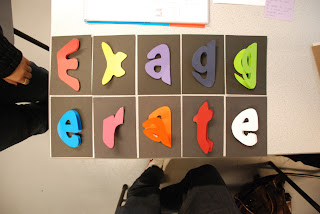

With these letters we were then asked to pick our favourite for the Digital side of the brief...







